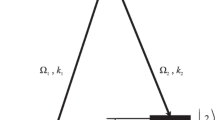Abstract.
We study the spatial profile of atomic fluorescence due to multiple photon scattering in two sealed glass optical cells, one with its internal surface coated with a polysilane film and the other uncoated. The radiation-trapping spatial profile is used as a probe of the excited-state population, and evidences the role of the surface in laser–atomic vapor volume processes. Each cell is distinguished from the other by a depolarization time which characterizes the internal surface state: in the coated cell, the longer depolarization time leads to a trapped fluorescence intensity smaller than in the uncoated cell. A simplified theoretical model taking into consideration the hyperfine polarization of the atoms by the resonant laser, the thermalization by collisions with the cell walls and the trapping of the fluorescence photons by ground-state atoms provides a good description of the observations.
Similar content being viewed by others
Author information
Authors and Affiliations
Additional information
Received: 27 December 2002 / Revised version: 31 March 2003 / Published online: 12 May 2003
RID="*"
ID="*"Corresponding author. Fax: +55-83/216-7513, E-mail: martine@otica.ufpb.br
Rights and permissions
About this article
Cite this article
Freitas, H., Rocha, A., Chevrollier, M. et al. Radiation trapping and spin relaxation of cesium atoms at cell walls . Appl Phys B 76, 661–666 (2003). https://doi.org/10.1007/s00340-003-1161-3
Issue Date:
DOI: https://doi.org/10.1007/s00340-003-1161-3




